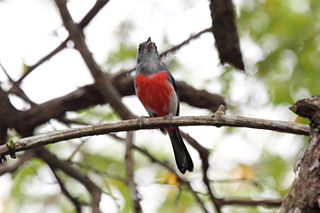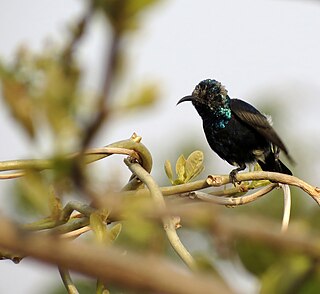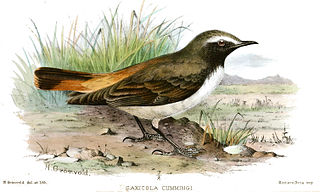
The chestnut-bellied sandgrouse or common sandgrouse is a species of sandgrouse. It is a sedentary and nomadic species that ranges from northern and central Africa and further east towards western and southern Asia. There are six recognised subspecies.

The black-throated bushtit, also known as the black-throated tit, is a very small passerine bird in the family Aegithalidae.
The Namuli apalis is a small African passerine bird belonging to the genus Apalis in the family Cisticolidae. It was formerly considered as a subspecies of the bar-throated apalis.

The bar-throated apalis is a small African passerine bird belonging to the genus Apalis of the family Cisticolidae. It is native to the eastern and southern Afrotropics.

The apalises are small passerine birds belonging to the genus Apalis, in the family Cisticolidae. They are found in forest, woodlands and scrub across most parts of sub-Saharan Africa. They are slender birds with long tails and have a slender bill for catching insects. They are typically brown, grey or green above and several species have brightly coloured underparts. Males and females are usually similar in appearance but the males are sometimes brighter.

The rufous-throated partridge is a species of bird in the family Phasianidae. It is found in montane forests in India and Southeast Asia. The International Union for Conservation of Nature (IUCN) has assessed it as a least-concern species.
The Kungwe apalis is a species in the family Cisticolidae. It was previously considered it to be a subspecies of the buff-throated apalis. It is found in Burundi, Democratic Republic of the Congo, Rwanda, and Tanzania.

The yellow-throated apalis is a passerine bird in the family Cisticolidae. It is endemic to Malawi. It was sometimes considered it to be a subspecies of the bar-throated apalis.
The Taita apalis is a bird in the family Cisticolidae that is endemic to the Taita Hills in Kenya. It was formerly considered to be a subspecies of the bar-throated apalis.
The Kabobo apalis is a species of bird in the family Cisticolidae. It is endemic to the Itombwe Mountains in eastern Democratic Republic of the Congo. Its natural habitat is tropical moist montane forests.

The grey-throated chat is a species of bird in the family Cardinalidae, the cardinals or cardinal grosbeaks. It is found in Belize, Guatemala, and Mexico.

The black sunbird is a species of bird in the family Nectariniidae. It is found in eastern Indonesia and New Guinea. Its natural habitats are subtropical or tropical moist lowland forest and subtropical or tropical mangrove forest.

Humblot's sunbird is a species of bird in the family Nectariniidae. It is endemic to the islands of Grand Comoro and Mohéli in the Comoros.

The Kurdish wheatear, also known as the Kurdistan wheatear, the chestnut-rumped wheatear or the red-rumped wheatear, is a species of bird in the family Muscicapidae. The red-tailed wheatear was formerly considered a subspecies of this bird but is now often regarded as a separate species. The two may intergrade in Iran but it is also possible that the rather differently coloured cummingi is in fact a one-year-old O. xanthoprymna with intermediate plumage.

The purple-throated cotinga is a species of bird in the cotinga family, Cotingidae. It is found in the western Amazon rainforest of South America; its range extends from southern Colombia south through eastern Ecuador and Peru and east through extreme northwestern Bolivia and into western Amazonian Brazil. It lives in the canopy or along the borders of humid forest throughout its range. The purple-throated cotinga is monotypic within the genus Porphyrolaema and has no known subspecies. It is one of the smaller cotinga species and expresses strong sexual dimorphism. Males have black upperparts with a bold white wingstripe and white edges to the tertial feathers and a white belly with some black barring on the rear flanks. The throat is a deep purple, giving the bird both its common and scientific names. Females are dark brown with pale buffy margins on the upperparts, buffy cinnamon with black barring on the underparts, and rufous on the throat. The male has a powerful voice.

The Mascarene paradise flycatcher is a species of bird in the monarch-flycatcher family Monarchidae. It is endemic to the Mascarene islands of Mauritius and Réunion. There are two subspecies recognized: the nominate subspecies from Réunion, also known as the Réunion paradise flycatcher; and T. b. desolata from Mauritius. The Mascarene paradise flycatcher was originally described in the genus Muscicapa and the subspecies T. b. desolata was originally described as a separate species.
The brown-headed apalis is a small passerine bird belonging to the genus Apalis in the family Cisticolidae. Formerly included within the grey apalis but is now commonly considered to be a separate species. It has two subspecies: A. a. alticola and A. a. dowsetti
The rufous-bellied helmetshrike or Gabon helmetshrike is a passerine bird belonging to the Vanga family, Vangidae. It inhabits tropical forest in Central Africa. It is sometimes included within the chestnut-bellied helmetshrike of West Africa.

The chestnut-hooded laughingthrush is a species of bird in the laughingthrush family Leiothrichidae endemic to Borneo. Described by the British ornithologist Richard Bowdler Sharpe as a distinct species in 1879, it was subsequently considered a subspecies of the chestnut-capped laughingthrush until 2007, when it was again raised to species status by the ornithologists Nigel Collar and Craig Robson. It is 22–24 cm (8.7–9.4 in) long, with a chestnut brown head and chin, with grey feathering on the top of the head. The upperparts and the side of the neck are slaty-grey, with a long white wing patch. The throat, breast, and upper belly are dull yellowish-brown, with purer grey flanks and a reddish-brown vent, lower belly, and thighs. It has a yellow half eye-ring behind and below the eye, while the tail has a blackish tip. Both sexes look similar, while juveniles are duller than adults.














